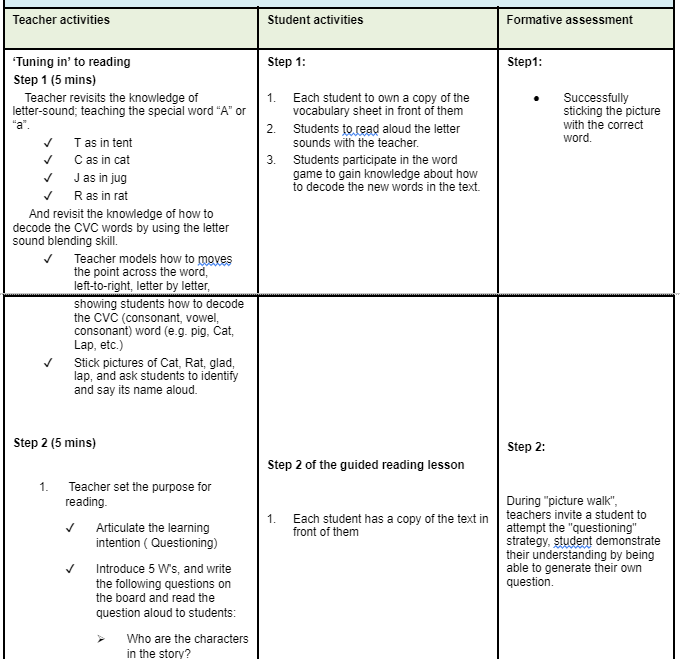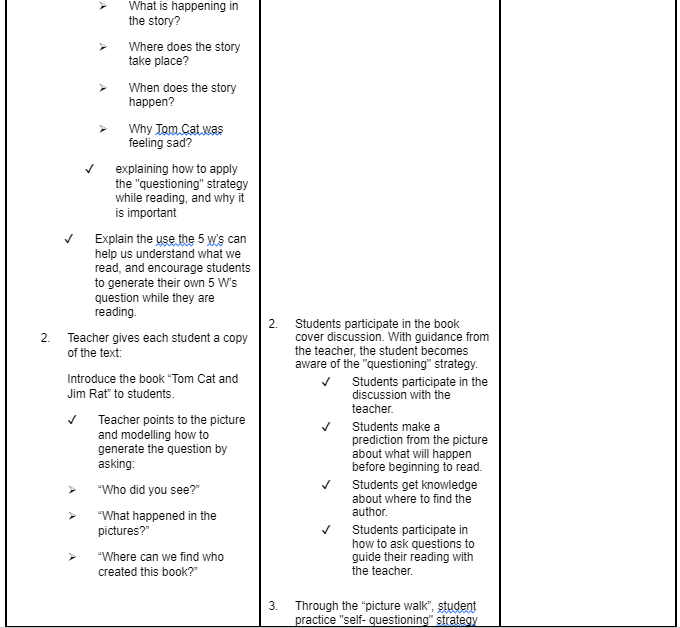Lesson Plan for Enhancing Reading Skills in Foundation Year Students
Rationale
Reading is essential for a child’s learning. However, numbers of students are facing learning difficulties due to their poor reading desire. There are barriers faced by children, especially by most EAL/D learner. These struggling learners need proper guidance to use good reading strategies, to overcome their reading difficulties and to become a happy reader (Wardle & Cruz-Jansen, 2004). Therefore, this lesson plan is constructed for purposes of formative reading assessments and it is also a requirement of English curriculum for foundation year, to support targeted student’s reading, and their use of reading strategies. For Education Dissertation Help, these strategies are crucial in fostering a supportive learning environment tailored to diverse student needs.








At the beginning of the guided lesson, it is important for a teacher to initiate a pre-reading discussion, and guide students on how to decode and understand the language in the text. The guidance may include revisiting the knowledge of how to handle the books, control left to right movement, revisit the knowledge of letter sound and teach students how to apply Sound-letter patterns (graphemes) for their reading experiences (First Steps, 2013). First, it is important to teach the special word “A” or “a” as it usually causes confusion for readers who are beginners. The teacher should also revisit the knowledge of CVC words such as “p-i-g”, model how to name the letters of “p-i-g” in the right order, how to mix the letter sound and read aloud. The aim of explicit teaching is to make reading smoother for an early reader (Rowe et al, 2005).
The picture-word-matching game gives students an opportunity to recognize the vocabulary with the matching picture. When students are reading the text, they will find it less challenging and become more engaged. The activity activates student’s prior knowledge with letter sound and integrate the knowledge with their developing decoding skill. It also gives an early reader an experience of success (Reiss, 2005).
Teaching students how to use comprehension strategy is a learning objective of this guided lesson. To achieve the objective, a teacher usually set a goal of reading with students at the beginning of the lesson (First Steps, 2013). It is vital as Tompkins et al., (2015) believes that proficient text user needs to be aware of the purpose of the text. When teaching the comprehension strategy to an early reader, it is important to make sure the teaching is clear and simple. The 5 W’s approach is a good example of what type of questions students can generate while they are reading (Queensland Education, 2017). The “questioning” strategy allows students to practice how to make a response when facing a problem and do an unconscious ‘think aloud’ as they read (Reiss, 2005). On the other hand, Pre-reading the title with guidance from teacher stimulates students’ motivation to read and develop learners’ awareness of a title. For instance, through title discussion, the student identifies the characters of text, authors of the text before the reading. They are then directed to make a prediction about the text events orally which is important to increase both understanding and articulation of words.
Silent reading is beneficial when students can link their prior knowledge to the text, apply the reading strategy and work out the problem by implementing the reading strategy. It also allows the teacher to provide individual support and conduct observations. During the reading time, some students may find the word “glad” difficult to decode as there are two consonants appear next to each other. Most EAL/D learner may find it challenging to work out combined consonant sounds. Therefore, it is a good time for the teacher to provide incidental teaching about phonics concepts. To foster students' learning skill, the teacher should not give out the answer at once when students are seeking help. Using questions like, “what can you see from the picture? What do you think Jim Rat is doing?” can be a great strategy to create understanding and development of the student. Students will be able to learn and use the same kind of strategy to solve their problems.
Once the silent reading is over, both the learners and the teacher and students sit in a circle to exchange idea of the lesson, summaries and draw conclusions. The conversation is critical to create student's ability to analyses the ideas from the lesson and comprehend the text (Thompkins et al., 2015). It is also an opportunity for learner to get an understanding of the lesson as well as the author’s idea (Thompkins et al., 2015, p283). Based on study, reading a book, the learner’s brain process both the literal words meaning and the link between words (Thompkins et al., 2015). For instance, to answer the question "why did dad taps Tom Cat?” from the text, the learner need to gathers all the information in the text together, to decode the meaning of the text, and to find out the authors point of view (Christie, (2005). Since this is a learner centered talk, the teacher should talk very little to give the learners opportunity to advance their knowledge (Tran, 2010). Regardless of this fact, the educator should also motivate their thinking by using questions. For instance, "why Tom Cat is sad?", "what can you see from page 8?" These questions review the learning, motivate thinking critically and stimulate students to pursue knowledge and as well as asking their own questions.
After the conversation, students are encouraged to revisit the text. This enables students to remember what they have just read as well as ascertain the uncertain text (Tran, 2010). During the conclusion, the teacher gathers the learners together. Apart from the knowledge that has been discussed, the teacher can ask the student to share their own reading experience. To motivate students to share their experience, the teacher should trigger the learners by asking questions such as; “Where do you find it difficult while you are reading?”; "did you use the reading strategy to solve the problem? How?" Students should in turns share their own experiences and generate their own questions which arose during reading Fellowes & Oakley, 2014).
Teaching pedagogy is more relevant and effective when a formative assessment is conducted as a true reflection of students' level of reading and used as an indication for future teaching plan. Tompkins et al., (2015), suggested that observation can be used as one of the formative assessment to record student's learning. During students' independent reading time, the teacher observes students’ body language and facial expressions to gain ideas of whether the selected text is appropriate for a student to use; when student encounter an unfamiliar word with the reading strategies they are using. Nicl & Macfarlane-Dick, (2006), indicate that it is more it is also useful for a student to have an idea about what strategies have been learned to activate their self-regulation and setting up the appropriate learning goal. To ensure that learners get knowledge of what they learned and continue to practice, reminding the learners to have a copy of the success criteria and come back to reread the text is important.

List of References
- Australian Curriculum and Assessment Reporting Authority (ACARA). (2014). Australian Curriculum: Literacy. Retrieved 26 March 2019 from https://www.acara.edu.au/curriculum
- Australian CURRICULUM. (2017). F-10 curriculum: English. Retrieved 26 March 2019 from https://www.australiancurriculum.edu.au/.
- Berryman, F & O’Carroll, P. (2015) Tom Cat and Jim Rat (12th ed.), North Fitzroy: The Fitzroy Readers
- Christie, F. (2005). Teaching reading, Language education in the primary years (1st ed.). Sydney: UNSW Press.
- Fellowes, J., & Oakley, G. (2014) Language, Literacy and Early Childhood Education (2nd ed.). South Melbourne: Oxford University Press
- First Steps. (2013). Reading Resource Book: Addressing Current Literacy Challenges. Retrieved from 20 March 2019 from http://det.wa.edu.au/stepsresources/detcms/navigation/first-steps-literacy/
- Freebody, P. & Luke, A. (1990). Literacies programs: Debates and demands in cultural context Prospect, An Australian Journal of TESOL, 5(3), 7-16, Retrieved http://eprints.qut.edu.au/49099/1/DOC090312.pdf.
- Jeanne, C. (2006). Guided reading with Emergent Readers, New York: Craig Low.
- Nicl, N. J. & Macfarlane-Dick, D. (2006). Formative assessment and self-regulated learning: a model and seven principles of good feedback practice. Studies in Higher Education, 31 (2), 199-218, Retrieved 23 March 2019 from DOI:10.1080/03075070600572090.
- Queensland Education. Department of Education and Training (2017) Pedagogical framework. Retrieved 25 March 2019 from https://education.qld.gov.au/curriculums/Documents/eald-learners.pdf
- Reiss, J. (2005). Teaching content to English language learners. New York: Pearson
- Rowe, K. & National Inquiry into the Teaching of Literacy (2005). "Teaching Reading" , Australian Council for Educational Research, Retrieved 29 March, 2019 from https://research.acer.edu.au/tll_misc/5
- Tompkins, G., Campbell, R., Green, D., & Smith, C. (2015). Literacy for the 21st Century: A balanced approach (2nd ed.). Melbourne: Pearson
- Tran, F. (2010). Teaching kids to read (1st ed.). Victoria: Wilkins Farago.
- Wardle, F., & Cruz-Jansen, M.I. (2004). Seven forms of cultural bias. In Meeting the needs of multiethnic and multiracial children in schools. (Pp. 188-192). Boston: Pearson.
- 24/7 Customer Support
- 100% Customer Satisfaction
- No Privacy Violation
- Quick Services
- Subject Experts



